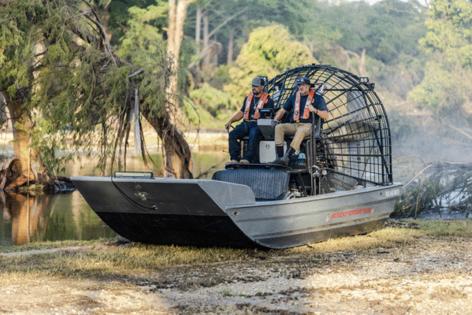Rescuers search for 160 Texas flood victims as death count rises
Published in News & Features
Crews in central Texas are digging through massive piles of debris, overturned vehicles and shattered homes for a sixth day as the search continues for victims of flash floods that killed more than 100 people over the Fourth of July weekend.
At least 160 people are still missing in Kerr Country, the hardest-hit area of the Texas Hill Country. Officials say no one has been found alive since July 4, when the deluge arrived in the pre-dawn hours, tearing through a 100-kilometer stretch of the Guadalupe River packed with vacationers. The waters inundated storied summer camps including Camp Mystic, where at least 27 children and counselors perished. Sheriff Larry Leitha said 2,100 people are involved in the response and the death toll in Kerry County alone has reached 95.
Authorities said they’re concentrating their efforts in areas around the river that are choked with debris. Crews are using excavators and skid loaders to comb through heaps of trees, homes and wreckage in search of victims.
More harrowing stories emerged from survivors, while demands grew for a fuller accounting of why more people didn’t get advance warning of the risks even as the National Weather Service sent out urgent alerts. Authorities have resisted discussing the specifics of the local response in the lead-up to the floods, saying the focus needed to be on recovery efforts.
Rena Bailey, 77, may have been saved by her habit of watching online storm maps when foul weather arrives. She was awake in the early morning hours of July 4 as thunderstorms pummeled her house in Hunt, Texas, monitoring the storm’s progress. Her home — where she’s lived since 1990 — is normally a short walk from the riverbank and is raised about six feet above ground level.
“I went outside and I noticed the water in the driveway was like about a foot high and I thought, hmm, that’s weird, I’ve never seen that before.” Bailey recalled in an interview. “Then all of a sudden it jumped up. And I saw the Hunt Store and heard it start to disintegrate. I saw the post office start to disintegrate, the office next to it and then this wall of water.”
She said she woke her husband and they watched the propane tanks from a gas stations float past. As the water climbed in their house, she said her husband helped her out a window and they climbed to higher ground.
She said she got a number of weather alerts about the risk of flooding, but didn’t act on them because the notices are fairly routine and the house had weathered many floods before.
“I just wish we’d gotten a better idea of what was happening,” she said.
Pressure for a detailed accounting of what happened are mounting. Questions are being asked about when weather forecasters first advised local officials about the potential for catastrophic flooding and what those officials did to spread the message.
Irene and Lucas Brake are still searching for Lucas’s parents, Joni Kay and Robert, who vanished during the floods. Irene and Lucas were staying at an RV park in Kerrville, while his parents had rented a nearby cabin for the holiday.
Irene said she stepped outside early July 4 to find water up to her waist. She and Lucas managed to reach safety but later learned that the cabin where Joni Kay and Robert were staying was swept away in the flood. No one has heard from them since.
Lucas has spent days walking the Guadalupe River looking for any sign of them. “We are doing our best to keep our heads high,” Irene said in an interview.
The area had a history of deadly deluges and was known locally as “Flash Flood Alley.” It lacked public alarms or warning sirens, partly due to the expense required to set them up. Weather alerts were sent to mobile phones in the area, but service is spotty in a largely rural region.
In total, at least 109 people have been confirmed dead across the state, and authorities say the toll is expected to rise. Additional storms around the state capital Austin on July 5 caused at least 14 deaths, with another dozen or so people still believed to be missing.
Survivors told news outlets they were awakened by barking dogs, the glare of flashing rescue lights, or the pounding storm that kept them tossing and turning through the night. Some stepped out of bed into cold water on the floor or were jolted awake by neighbors pounding on doors.
At Wednesday’s press conference, Kerrville Community Services Officer Jonathan Lamb recounted rescue stories, including a patrol sergeant who used his loudspeaker to wake-up residents before spending 13 hours wading through floodwaters with others to pull people from vehicles and off rooftops. In another case, a man used a garden hose as a safety line to save someone from a fast-moving current.
“I know this tragedy — how horrific as it was — could have been so much worse,” said Lamb.
Local officials have pushed back on suggestions they could have acted sooner to warn residents and visitors. They say the rural terrain, which includes low water crossings and single-lane bridges, could have left evacuees stranded on the road and in danger of being swept away.
“There are rural areas that may experience extended response times, areas where cell service is spotty, where there are single-lane bridges, and low water crossings,” Governor Greg Abbott said in a statement. “Sometimes evacuation is not the safest choice; sometimes the safer choice is shelter-in-place. The Hill Country is not one-size-fits all.”
He pledged a thorough investigation of what happened “to identify areas for improvement in our response protocols.” Abbott also ordered Texas flags to be lowered to half-staff Wednesday in memory of the victims.
Abbott has also said lawmakers will address flood warning systems in a special session of the Texas legislature starting July 21, and Lieutenant Governor Dan Patrick said the state would find a way to pay for natural-disaster alarms for the area. AccuWeather estimated the disaster may have caused $18 billion to $22 billion in economic losses and property damage statewide.
Texas is especially prone to natural catastrophes, partly because it’s so big. In the past decade, Texas has been in the top 10 states for weather-related economic losses, according to National Weather Service records. From 2015 to 2024, 654 people died as a direct result of weather. Texas accounts for 31% of all damages caused by extreme weather in the U.S. during the last 10 years.
Brandon Rothwell, 56, was volunteering in Hunt this week, helping cook food for victims and search-and-rescue crews at an outdoor grill. He grew up in Hunt and was in Kerrville when the floods struck, but far enough away from the river to be safe.
“This storm was like a mini hurricane,” he said. “The river here is like a rock quarry in a way. There’s a lot of rock and canyons. Water just came down.”
He said the area is resilient, and predicted most of it would be rebuilt within six months. Neighbors are already working to help each other, he said.
“Everyone pulled together with love,” he said. “We’re Texans. That’s what we do.”
©2025 Bloomberg L.P. Visit bloomberg.com. Distributed by Tribune Content Agency, LLC.







Comments